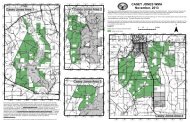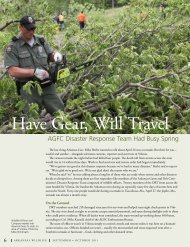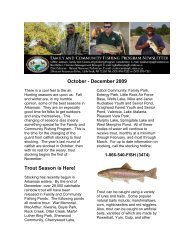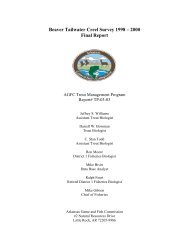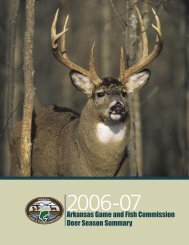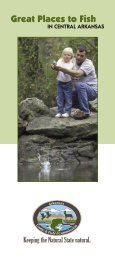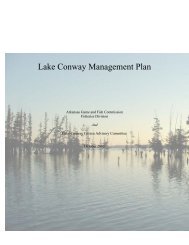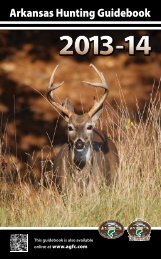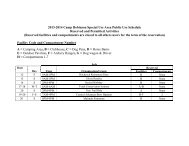View Article - Arkansas Game and Fish Commission
View Article - Arkansas Game and Fish Commission
View Article - Arkansas Game and Fish Commission
- No tags were found...
Create successful ePaper yourself
Turn your PDF publications into a flip-book with our unique Google optimized e-Paper software.
“These mounds were built a bucket of dirt at a time,” Carltonsaid. “They’re not really solid <strong>and</strong> they erode very easily.”That’s why a crew of 12 got together in summer heat fora work day. The <strong>Arkansas</strong> <strong>Game</strong> <strong>and</strong> <strong>Fish</strong> <strong>Commission</strong>, the<strong>Arkansas</strong> Archeological Survey, the <strong>Arkansas</strong> ArcheologicalAssociation, the Natural Resources Conservation Service <strong>and</strong><strong>Arkansas</strong> State Parks pitched in with tools, materials <strong>and</strong> peoplepower. The individuals brought expertise in biology, archeology,conservation, interpretation <strong>and</strong> probably a few other areas.A section of lakeshore about 50 feet long needed protection.Coconut matting – it looks like burlap on a carpet roll – wassecured along the steep bank to keep wave action from digginginto the fragile dirt. At the bottom of the matting, nearest thewater, logs were anchored with steel cables so they wouldn’t floataway with changing tides.“The idea (of using logs) came from a tree falling naturally<strong>and</strong> the earth behind it not eroding as easily,” said Steve Filipek,assistant chief of the AGFC <strong>Fish</strong>eries Division. “The mat takesaway the power of water washing against the ground. We’llplant some things like white clover <strong>and</strong> river cane to help hold ittogether. It will have a very natural look from the lake.”The coconut mat also becomes good mulch as it deteriorates<strong>and</strong> plants begin to grow. These techniques <strong>and</strong> others are usedby the AGFC’s Stream Teams across the state to stabilize <strong>and</strong>restore river banks.It’s a simple but time-consuming <strong>and</strong> withering task. Woodenstakes are pounded through the mat to hold it in place. Theheavy logs are toted by h<strong>and</strong> <strong>and</strong> the cables that secure them areanchored through roots <strong>and</strong> rocks. It’s a hot, sweaty, bug-infestedproduction.But maintaining the site is worth the effort.Toltec Mounds, a National Historic L<strong>and</strong>mark, was named bythe owner of the property in the 1800s who thought Toltecs fromMexico built the mounds. Research later revealed these moundswere part of the Plum Bayou Culture, people who lived alongthe rivers of eastern <strong>and</strong> central <strong>Arkansas</strong>. Toltec Mounds is thelargest Plum Bayou site.Some of the mounds at Toltec are low <strong>and</strong> hard to recognize.“These mounds were probably not much bigger than they arenow,” said Elizabeth Horton, a paleoethnobotonist with theUniversity of <strong>Arkansas</strong> Archeology Survey, based at the ToltecMounds Research Station, as she stood at Mound P.Farmers over the years pulled apart mounds across the region.Although not all mounds were as majestic as the Toltec examples,they were plentiful.“We have some interesting surveys in the 1800s <strong>and</strong> sketchesthat show the mounds,” Horton said.Toltec holds the largest American Indian mounds in<strong>Arkansas</strong>. They were surrounded by a dirt embankment 8-10 feethigh, part of which remains. The mounds <strong>and</strong> wall were part of acomplex where ceremonies were held <strong>and</strong> business conducted.For more information about the park, visit www.arkansasstateparks.com/toltecmounds or call 501-961-9442. AWA sample of artifacts that were picked off the site before matting was applied.Photo by Mike Wintroath.Stephen O’Neal (left) <strong>and</strong> Steve Filipek of the AGFC drive a cable into theground to secure a log. Photo by Mike Wintroath.NOVEMBER • DECEMBER 2011ARKANSAS WILDLIFE17




